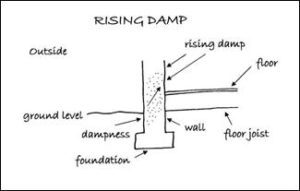We use professional moisture meters to measure moisture levels within masonry at different heights. These readings help identify patterns consistent with rising damp. Visual indicators such as salt deposits and mortar breakdown are also assessed.
There are a couple of different ways this can be done: either with a hawk and trowel, or with a gun. Our qualified tradesmen use guns to inject the mortar between the bricks as this method has proven to give a superior finish and result to our clients.
Tuckpointing is a specialised brick finish, originally done in the early 1900’s to “hide” unevenly shaped bricks.
Instead of seeing bricks and mortar, the mortar is covered over by a darker coloured stain or base, and then a fine raised white line goes over the top. It is a very neat and attractive finish which can add a lot of value to homes when done well.
Tuckpointing can be done over new or old brickwork, or even over the top of render. Buildings which have been painted can also be tuckpointed. The paint or render can be stripped, or chiselled back, leaving exposed bricks which can then be restored and then tuckpointed. Another option (often cheaper but just as effective) for rendered buildings, is to tuckpoint over the top!
Repointing is also known as “Mortar Pointing” and “Mortar Re-Pointing”. They are all the same thing. Repointing is done when the mortar between the bricks is breaking down and “fretting” or decaying.
These two are often confused but are actually very different. Mortar Pointing or Re-Pointing means to repair the existing mortar joints. With Tuckpointing, you don’t actually see the mortar joints as they are stained over with a dark coloured base and then a fine white line protrudes over the top.
If the mortar joints are intact but uneven or visually tired, tuckpointing may be suitable. If the mortar is cracked, loose, or missing, repointing is required. An on-site assessment confirms the correct approach.
The joint is the type of finish between the bricks. There are many of these which include: Flush, struck and cut, rolled, recessed, etc. If you’d like more information on this, just send us an enquiry!
Like there is a basketweave pattern in paving, so too you can have different patterns in bricklaying. Flemmish Bond is a pattern of laying bricks where the “stretcher” (longest length) and a “header” (shortest length) are laid alternately along the course of brickwork. There are many variations on this theme, all with different names.
A lintel is a horizontal beam, used to give structural strength and support around openings such as doors and windows. Lintels can either consist of metal, concrete or wood – and all are subject to decay.
Metal lintels can rust and expand and cause the surrounding brickwork to crack, causing structural damage. Galvanised lintels are used to replace the rusting lintels which ensure the problem does not re-occur.
This is an older style of rendering, popular around Federation era. This render is heavily texturised, often used in conjunction with tuckpointing.
It has small gravel added to give the finish a bubble-like effect and it’s finish is quite rough and “lumpy”. It is known both as Roughcast Render and also Stucco.
Fretting is the decay or break-down of either mortar or bricks. This decay is caused by a number of factors, including weather, water, chemical reactions, inferior grade products etc.

Rising damp occurs when moisture from the ground travels upward through masonry walls. It typically affects the lower sections of brickwork and is identified by damp staining, salt deposits, and deteriorating mortar or finishes. Accurate diagnosis is important, as other moisture issues can present in similar ways and require different solutions.
We use professional moisture meters to measure moisture levels within masonry at different heights. These readings help identify patterns consistent with rising damp. Visual indicators such as salt deposits and mortar breakdown are also assessed.
No. Photos assist with initial advice but accurate diagnosis requires on-site inspection and moisture readings. Incorrect diagnosis leads to incorrect treatment.
No. Photos assist with initial advice but accurate diagnosis requires on-site inspection and moisture readings. Incorrect diagnosis leads to incorrect treatment.
Yes, but correcting recent or poor-quality tuckpointing is more complex than starting fresh. Fresh mortar is harder to remove cleanly, which increases labour and cost. New mortar bonds tightly to brick edges and requires careful removal to avoid damage. This adds time and complexity compared to original tuckpointing work.
Limestone is a highly porous material. It absorbs moisture easily and allows salts to move through the stone. Over time, this can lead to fretting and surface breakdown that is outside of our control, even when the work is carried out correctly.
Because of this, limestone repointing does not always qualify for the same 10-year guarantee we provide on our other brickwork. Each limestone project is assessed individually, and any guarantee limitations are explained clearly before work begins.
More Questions?
If you have any more questions please get in contact with one of our specialists!
